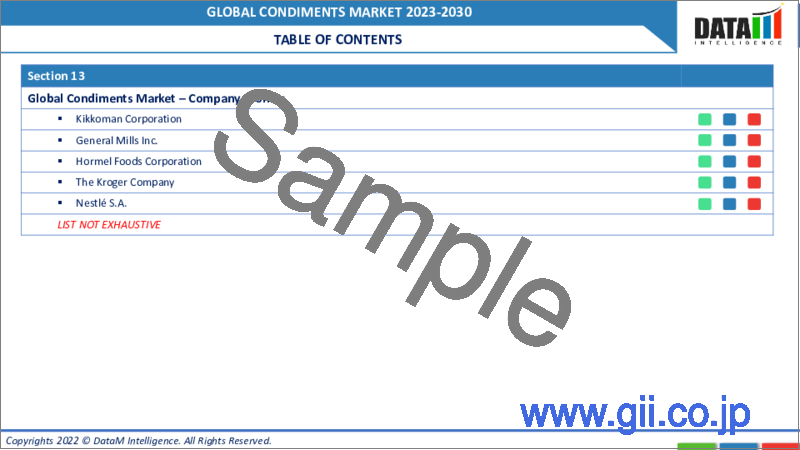|
|
市場調査レポート
商品コード
1304581
調味料の世界市場- 2023年~2030年Global Condiments Market - 2023-2030 |
||||||
カスタマイズ可能
適宜更新あり
|
|||||||
| 調味料の世界市場- 2023年~2030年 |
|
出版日: 2023年07月07日
発行: DataM Intelligence
ページ情報: 英文 190 Pages
納期: 即日から翌営業日
|
- 全表示
- 概要
- 目次
市場概要
調味料の世界市場は2022年に115億米ドルに達し、2030年には171億米ドルに達すると予測され、予測期間2023-2030年のCAGRは5.1%で成長する見込みです。消費者は、食事を刺激する大胆でエキゾチックな風味の調味料をますます求めるようになっています。例えば、Cholula社は、Chipotle、Chili Lime、Green Pepperのようなユニークな風味の組み合わせを持つ様々なホットソースを提供しています。
植物ベースの食生活の人気が高まるにつれ、植物ベースやビーガンフレンドリーな調味料の需要が高まっています。消費者は、従来の動物性製品に代わるものとして、植物性原料から作られたソースを求めています。各ブランドは、動物性原料の代替としてアボカド、豆腐、植物油などの原料を使用した植物性マヨネーズ、ドレッシング、スプレッドを発売しています。
忙しいライフスタイルに伴い、消費者は便利で持ち運びができ、外出先でも使える調味料の選択肢を求めています。小袋、スクイーズボトル、トラベルサイズのパックなど、1回分ずつ持ち運べるパッケージが人気を集めています。こうした形態は多忙なライフスタイルに対応し、消費者が移動中に調味料を簡単に持ち運んで使うことを可能にします。
市場力学
大陸間の料理や風味豊かな料理を試したいという消費者の欲求が、調味料業界の市場成長を後押ししています
世界化によって文化交流が活発になり、世界中の多様な料理に触れる機会が増えています。消費者は、さまざまな国や地域の新しい味、食材、料理スタイルを試すことに前向きになっています。大陸間の料理を探求し、体験したいというこの欲求は、これらの料理で本物の味を作り出すのに不可欠な調味料の需要を高めています。たとえば、中国では、2021年の全国の調味料および調味料生産量の3分の1近くが醤油でした。
フード・ツーリズムは人気のトレンドとなっており、旅行者は旅行中にユニークな食体験を求めています。人々は旅行先でその土地の料理や味を試したがるため、家庭でその味を再現できる調味料の需要が高まっています。この動向は、消費者が世界各国の料理の味を台所に持ち込もうとするため、調味料市場の成長を牽引しています。
家庭料理と食事の準備の増加が調味料市場の成長を牽引
家庭で料理をする人が増えるにつれて、家庭料理の味を引き立てる調味料の需要が高まっています。ソース、マリネ、ドレッシング、調味料などの調味料は、家庭料理に深みと複雑さを加える簡単で便利な方法を提供します。シンプルな食材を風味豊かでレストラン並みの料理に変身させ、料理体験全体をより楽しいものにしてくれます。
家庭料理は、個人の嗜好や食事制限、風味の特徴に合わせて食事をカスタマイズする機会を提供します。調味料を使うことで、消費者は辛さのレベルを調整したり、酸味を加えたり、特定の風味を引き立てたりと、自分の好みに合わせて料理の味を調整することができます。
調味料を使って食事をパーソナライズできることが、市場における幅広い選択肢の需要を後押ししています。例えば、ケチャップはアメリカ人一人当たり年間約5.1キログラム消費されるのに対し、他のソース類はすべて合わせて7.1キログラムです。マヨネーズ、マスタード、バーベキューソースなどもその一例です。
健康上の懸念とネガティブな認識が調味料市場の成長抑制要因になる可能性
従来の調味料の多くは塩分、糖分、脂肪分を多く含んでおり、肥満、高血圧、糖尿病といった健康上の懸念の一因となっています。消費者の健康意識が高まり、これらの成分が健康に与える影響について知識を得るにつれ、これらの成分が過剰に含まれる調味料を減らすか避けるようになるかもしれないです。その結果、特定の調味料に対する需要が減少し、市場の成長が制限される可能性があります。
調味料の中には、特に砂糖や不健康な脂肪を多く含むものがあり、食事の栄養価に悪影響を及ぼす可能性があります。健康志向の消費者は、調味料を空のカロリーや、バランスのとれた健康的な食生活を維持する努力を損なう添加物と認識する可能性があります。このような否定的な認識は、調味料を敬遠させたり、消費者がより健康的な代替品を求めるきっかけとなり、従来の調味料の市場成長を抑制する可能性があります。
COVID-19影響分析
COVID-19分析には、COVID前シナリオ、COVIDシナリオ、COVID後シナリオに加え、価格力学(COVID前シナリオと比較したパンデミック中およびパンデミック後の価格変動を含む)、需給スペクトラム(取引制限、封鎖、およびその後の問題による需給の変化)、政府の取り組み(政府機関による市場、セクター、業界を活性化させる取り組み)、メーカーの戦略的取り組み(COVID問題を緩和するためにメーカーが行ったことをここで取り上げる)が含まれます。
ロシア・ウクライナ戦争の影響
戦争は調味料原料、包装材料、完成品のサプライチェーンを混乱させる可能性があります。国境閉鎖、貿易の混乱、輸送の困難といった紛争関連の問題は、影響を受けた地域における調味料の入手の遅れや不足につながる可能性があります。これは、ウクライナとロシアの両国のみならず、潜在的には近隣諸国の調味料市場の成長と入手可能性に影響を与える可能性があります。
目次
第1章 調査手法と調査範囲
第2章 定義と概要
第3章 エグゼクティブサマリー
第4章 市場力学
- 市場への影響要因
- 促進要因
- 多国籍料理や風味豊かな料理を試したいという消費者の欲求
- 家庭での調理と食事の準備の増加
- 抑制要因
- 健康への懸念と否定的な認識
- 機会
- 製品イノベーション
- 影響分析
- 促進要因
第5章 産業分析
- ポーターのファイブフォース分析
- サプライチェーン分析
- 価格分析
- 規制分析
第6章 COVID-19分析
第7章 製品タイプ別
- ソース&ケチャップ
- スパイス
- ドレッシング
- その他
第8章 包装材料
- プラスチック
- ガラス
- 紙
- その他
第9章 流通チャネル別
- ハイパーマーケット・スーパーマーケット
- コンビニエンスストア
- ネット通販
- その他
第10章 地域別
- 北米
- 米国
- カナダ
- メキシコ
- 欧州
- ドイツ
- 英国
- フランス
- イタリア
- スペイン
- その他欧州
- 南米
- ブラジル
- アルゼンチン
- その他南米
- アジア太平洋
- 中国
- インド
- 日本
- オーストラリア
- その他アジア太平洋地域
- 中東・アフリカ
第11章 競合情勢
- 競合シナリオ
- 市況/シェア分析
- M&A分析
第12章 企業プロファイル
- Conagra Brands, Inc.
- 会社概要
- 製品ポートフォリオと説明
- 財務概要
- 主な発展
- Kewpie Corp.
- McCormick & Co., Inc.
- The Kraft Heinz Co.
- Unilever Plc
- Mars Incorporated
- General Mills Inc.
- Hormel Foods Corporation
- The Kroger Company
- Nestle S.A.
第13章 付録
Market Overview
The Global Condiments Market reached US$ 11.5 billion in 2022 and is expected to reach US$ 17.1 billion by 2030, growing with a CAGR of 5.1% during the forecast period 2023-2030. Consumers increasingly seek condiments with bold and exotic flavor profiles that excite their meals. For example, Cholula offers a variety of hot sauces with unique flavor combinations like Chipotle, Chili Lime, and Green Pepper.
With the growing popularity of plant-based diets, there is a rising demand for plant-based and vegan-friendly condiments. Consumers seek sauces made from plant-based ingredients as alternatives to traditional animal-based products. Brands are introducing plant-based mayo, dressings, and spreads that use ingredients like avocado, tofu, or plant oils as alternatives to animal-based ingredients.
With busy lifestyles, consumers are seeking convenient, portable, and on-the-go condiment options. Single-serve and on-the-go packaging formats, such as portion-controlled sachets, squeeze bottles, and travel-sized packs, are gaining popularity. These formats cater to busy lifestyles and allow consumers to easily carry and use condiments while on the move.
Market Dynamics
The Consumer Desire to Try Intercontinental Cuisines and Flavor-Rich Dishes is Indeed Driving the Market Growth of the Condiments Industry
Globalization has led to increased cultural exchange and exposure to diverse cuisines from around the world. Consumers are more open to trying new flavors, ingredients, and cooking styles from different countries and regions. This desire to explore and experience intercontinental cuisines fuels the demand for condiments that are integral to creating authentic flavors in these dishes. For instance, in China, nearly a third of the nation's production of seasonings and condiments in 2021 was soy sauce.
Food tourism has become a popular trend, with travelers seeking unique culinary experiences during their trips. People are eager to try local dishes and flavors wherever they travel, leading to an increased demand for condiments that can recreate those flavors at home. This trend drives the growth of the condiments market as consumers seek to bring the taste of international cuisines into their kitchens.
Increased Home Cooking and Meal Preparation is Driving the Condiments Market Growth
As more people cook at home, there is a greater demand for Condiments to enhance the flavors of homemade dishes. Condiments such as sauces, marinades, dressings, and seasonings provide an easy and convenient way to add depth and complexity to home-cooked meals. They can transform simple ingredients into flavorful and restaurant-quality dishes, making the overall cooking experience more enjoyable.
Home cooking provides the opportunity for individuals to customize their meals according to personal preferences, dietary restrictions, and flavor profiles. Condiments enable consumers to tailor the taste of their dishes to suit their tastes, whether it's adjusting the level of spiciness, adding tanginess, or enhancing specific flavor notes.
The ability to personalize meals using condiments drives the demand for a wide range of options in the market. For instance, Ketchup is consumed annually by Americans per capita at a rate of about 5.1 kilograms, compared to 7.1 kilograms for all other sauces combined. Mayonnaise, mustard, and BBQ sauce are some of these sauces.
Health Concerns and Negative Perceptions Can act as Restraints for the Growth of the Condiments Market
Many traditional condiments contain high salt, sugar, and fat levels, which can contribute to health concerns such as obesity, high blood pressure, and diabetes. As consumers become more health-conscious and educated about the impact of these ingredients on their well-being, they may choose to reduce or avoid condiments with excessive levels of these components. This can result in decreased demand for certain condiments and limit market growth.
Some condiments, especially those high in sugar and unhealthy fats, can negatively impact the nutritional value of meals. Health-conscious consumers may perceive condiments as empty calories or as additives that undermine their efforts to maintain a balanced and healthy diet. This negative perception can discourage condiments or lead consumers to seek healthier alternatives, potentially restraining the market growth of traditional condiments.
COVID-19 Impact Analysis
The COVID-19 Analysis includes Pre-COVID Scenario, COVID Scenario, and Post-COVID Scenario along with Pricing Dynamics (Including pricing change during and post-pandemic comparing it with pre-COVID scenarios), Demand-Supply Spectrum (Shift in demand and supply owing to trading restrictions, lockdown, and subsequent issues), Government Initiatives (Initiatives to revive market, sector or Industry by Government Bodies) and Manufacturers Strategic Initiatives (What manufacturers did to mitigate the COVID issues will be covered here).
Russia-Ukraine War Impact
The war can disrupt supply chains for condiment ingredients, packaging materials, and finished products. Conflict-related issues such as border closures, trade disruptions, and transportation challenges can lead to delays or shortages in the availability of condiments in affected regions. This can impact the market growth and availability of condiments in both Ukraine and Russia, as well as potentially in neighboring countries.
Segment Analysis
The Global Condiments Market is segmented based on product type, packaging material, distribution channel, and region.
Versatility and Wide Consumption of Sauces & Ketchup
The Global condiments market has been segmented by type into sauces & ketchup, spices, dressings, and others.
In 2022, sauces & ketchup had the highest share of the condiments market. Sauces and ketchup are versatile condiments that can be used with a wide range of dishes. They complement various cuisines, including Western, Asian, and Mediterranean, making them popular and widely consumed across different regions and cultures. For instance, according to Statista, nearly 427 thousand metric tonnes of ketchup and other tomato sauces were sold in CIS nations in 2020. The versatility allows for broad applicability, making them a staple in many households and food establishments.
Sauces and ketchup have a broad consumer appeal, appealing to both adults and children alike. They are commonly used as toppings, dressings, and dipping sauces for various food items such as burgers, sandwiches, fries, nuggets, and salads. Their familiar flavors and textures make them a preferred choice for many consumers.
Geographical Analysis
Large Consumer Base for Condiments Market in North America region
In 2022, North America had a significant share of the condiments market. North America has a substantial population, including the United States, Canada, and Mexico. This large consumer base provides a significant market for condiments, creating opportunities for manufacturers and driving the market growth. For instance, according to Statista, With sales of around 164 million dollars in the United States in 2021, mayonnaise was the most popular condiment there.
North America is known for its culinary diversity and global food influences. The region has a diverse population with varying cultural backgrounds, leading to a demand for a wide range of condiments that cater to different flavor profiles and cuisines. This diversity and openness to global flavors contribute to the growth and popularity of condiments in the North American market.
Competitive Landscape
The major global players in the market include: Conagra Brands, Inc., Kewpie Corp., McCormick & Co., Inc., The Kraft Heinz Co., Unilever Plc, Mars Incorporated, General Mills Inc., Hormel Foods Corporation, The Kroger Company, Nestle S.A.
Why Purchase the Report?
- To visualize the global condiments market segmentation based on product type, packaging material, distribution channel, and region, as well as understand key commercial assets and players.
- Identify commercial opportunities by analyzing trends and co-development.
- Excel data sheet with numerous data points of condiments market-level with all segments.
- PDF report consists of a comprehensive analysis after exhaustive qualitative interviews and an in-depth study.
- Product mapping available as excel consisting of key products of all the major players.
The Global Condiments Market Report Would Provide Approximately 61 Tables, 61 Figures And 190 Pages.
Target Audience 2023
- Manufacturers/ Buyers
- Industry Investors/Investment Bankers
- Research Professionals
- Emerging Companies
Table of Contents
1. Methodology and Scope
- 1.1. Research Methodology
- 1.2. Research Objective and Scope of the Report
2. Definition and Overview
3. Executive Summary
- 3.1. Market Snippet, by Product Type
- 3.2. Market Snippet, by Packaging Material
- 3.3. Market Snippet, by Distribution Channel
- 3.4. Market Snippet, by Region
4. Market Dynamics
- 4.1. Market Impacting Factors
- 4.1.1. Drivers
- 4.1.1.1. The Consumer Desire to Try Intercontinental Cuisines and Flavor-Rich Dishes
- 4.1.1.2. Increased Home Cooking and Meal Preparation
- 4.1.2. Restraints
- 4.1.2.1. Health Concerns and Negative Perceptions
- 4.1.3. Opportunity
- 4.1.3.1. Product Innovation
- 4.1.4. Impact Analysis
- 4.1.1. Drivers
5. Industry Analysis
- 5.1. Porter's Five Force Analysis
- 5.2. Supply Chain Analysis
- 5.3. Pricing Analysis
- 5.4. Regulatory Analysis
6. COVID-19 Analysis
- 6.1. Analysis of COVID-19 on the Market
- 6.1.1. Scenario Before COVID-19
- 6.1.2. Scenario During COVID-19
- 6.1.3. Scenario Post COVID-19
- 6.2. Pricing Dynamics Amid COVID-19
- 6.3. Demand-Supply Spectrum
- 6.4. Government Initiatives Related to the Market During Pandemic
- 6.5. Manufacturers Strategic Initiatives
- 6.6. Conclusion
7. By Product Type
- 7.1. Introduction
- 7.1.1. Market Size Analysis and Y-o-Y Growth Analysis (%), By Product Type
- 7.1.2. Market Attractiveness Index, By Product Type
- 7.2. Sauces & Ketchup*
- 7.2.1. Introduction
- 7.2.2. Market Size Analysis and Y-o-Y Growth Analysis (%)
- 7.3. Spices
- 7.4. Dressings
- 7.5. Others
8. Packaging Material
- 8.1. Introduction
- 8.1.1. Market Size Analysis and Y-o-Y Growth Analysis (%), By Packaging Material
- 8.1.2. Market Attractiveness Index, By Packaging Material
- 8.2. Plastics*
- 8.2.1. Introduction
- 8.2.2. Market Size Analysis and Y-o-Y Growth Analysis (%)
- 8.3. Glass
- 8.4. Paper
- 8.5. Others
9. By Distribution Channel
- 9.1. Introduction
- 9.1.1. Market Size Analysis and Y-o-Y Growth Analysis (%), By Distribution Channel
- 9.1.2. Market Attractiveness Index, By Distribution Channel
- 9.2. Hypermarket/Supermarket*
- 9.2.1. Introduction
- 9.2.2. Market Size Analysis and Y-o-Y Growth Analysis (%)
- 9.3. Convenience Stores
- 9.4. Online Retails
- 9.5. Others
10. By Region
- 10.1. Introduction
- 10.1.1. Market Size Analysis and Y-o-Y Growth Analysis (%), By Region
- 10.1.2. Market Attractiveness Index, By Region
- 10.2. North America*
- 10.2.1. Introduction
- 10.2.2. Key Region-Specific Dynamics
- 10.2.3. Market Size Analysis and Y-o-Y Growth Analysis (%), By Product Type
- 10.2.4. Market Size Analysis and Y-o-Y Growth Analysis (%), By Packaging Material
- 10.2.5. Market Size Analysis and Y-o-Y Growth Analysis (%), By Distribution Channel
- 10.2.6. Market Size Analysis and Y-o-Y Growth Analysis (%), By Country
- 10.2.6.1. The U.S.
- 10.2.6.2. Canada
- 10.2.6.3. Mexico
- 10.3. Europe
- 10.3.1. Introduction
- 10.3.2. Key Region-Specific Dynamics
- 10.3.3. Market Size Analysis and Y-o-Y Growth Analysis (%), By Product Type
- 10.3.4. Market Size Analysis and Y-o-Y Growth Analysis (%), By Packaging Material
- 10.3.5. Market Size Analysis and Y-o-Y Growth Analysis (%), By Distribution Channel
- 10.3.6. Market Size Analysis and Y-o-Y Growth Analysis (%), By Country
- 10.3.6.1. Germany
- 10.3.6.2. The U.K.
- 10.3.6.3. France
- 10.3.6.4. Italy
- 10.3.6.5. Spain
- 10.3.6.6. Rest of Europe
- 10.4. South America
- 10.4.1. Introduction
- 10.4.2. Key Region-Specific Dynamics
- 10.4.3. Market Size Analysis and Y-o-Y Growth Analysis (%), By Product Type
- 10.4.4. Market Size Analysis and Y-o-Y Growth Analysis (%), By Packaging Material
- 10.4.5. Market Size Analysis and Y-o-Y Growth Analysis (%), By Distribution Channel
- 10.4.6. Market Size Analysis and Y-o-Y Growth Analysis (%), By Country
- 10.4.6.1. Brazil
- 10.4.6.2. Argentina
- 10.4.6.3. Rest of South America
- 10.5. Asia-Pacific
- 10.5.1. Introduction
- 10.5.2. Key Region-Specific Dynamics
- 10.5.3. Market Size Analysis and Y-o-Y Growth Analysis (%), By Product Type
- 10.5.4. Market Size Analysis and Y-o-Y Growth Analysis (%), By Packaging Material
- 10.5.5. Market Size Analysis and Y-o-Y Growth Analysis (%), By Distribution Channel
- 10.5.6. Market Size Analysis and Y-o-Y Growth Analysis (%), By Country
- 10.5.6.1. China
- 10.5.6.2. India
- 10.5.6.3. Japan
- 10.5.6.4. Australia
- 10.5.6.5. Rest of Asia-Pacific
- 10.6. Middle East and Africa
- 10.6.1. Introduction
- 10.6.2. Key Region-Specific Dynamics
- 10.6.3. Market Size Analysis and Y-o-Y Growth Analysis (%), By Product Type
- 10.6.4. Market Size Analysis and Y-o-Y Growth Analysis (%), By Packaging Material
- 10.6.5. Market Size Analysis and Y-o-Y Growth Analysis (%), By Distribution Channel
11. Competitive Landscape
- 11.1. Competitive Scenario
- 11.2. Market Positioning/Share Analysis
- 11.3. Mergers and Acquisitions Analysis
12. Company Profiles
- 12.1. Conagra Brands, Inc.*
- 12.1.1. Company Overview
- 12.1.2. Product Portfolio and Description
- 12.1.3. Financial Overview
- 12.1.4. Key Developments
- 12.2. Kewpie Corp.
- 12.3. McCormick & Co., Inc.
- 12.4. The Kraft Heinz Co.
- 12.5. Unilever Plc
- 12.6. Mars Incorporated
- 12.7. General Mills Inc.
- 12.8. Hormel Foods Corporation
- 12.9. The Kroger Company
- 12.10. Nestle S.A.
LIST NOT EXHAUSTIVE
13. Appendix
- 13.1. About Us and Services
- 13.2. Contact Us






